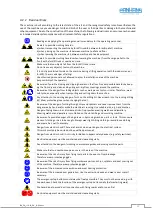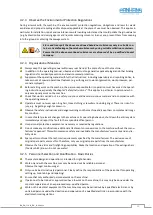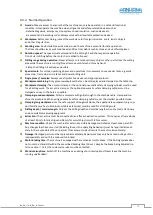
BA_PH_116-10_EN_12-22.docx
23
7.4
Temporary Storage
If the machine is not put into operation immediately after delivery, it must be stored carefully in a protected
place. Carefully cover the entire machine so that neither dust nor moisture can penetrate.
The bare, non-surface-treated parts (e.g. the cast iron tabletop) are provided with a preservative. This must be
checked regularly for effectiveness and renewed if necessary.
7.5
Lashing on a Transport Vehicle
For transport with a truck, the machine must be lashed to the loading area of the truck (as for delivery) standing
upright on a transport pallet.
The responsibility for safe loading is borne by the respective shipper!
At least two lashing straps must be used, each of which must be individually tensioned on the
loading area of the truck! The palletised machine must be additionally secured against slipping
and tipping over in the vehicle.
Please note the following when lashing in the transport vehicle:
•
For transport, the movable drill support must be fixed to the table top using the transport lock (see
•
The loading area of the transport vehicle must always be clean and dry.
•
The lashing straps used must be suitable for the total weight of the machine (see section
5.1).
•
Fastening on the loading area is done by lashing down: This means that the transport pallet is secured by
frictional locking. The load is pressed so firmly onto the loading surface that it can no longer slip. The clamp-
ing tool should have a high STF value at the frictional connection, e.g. long-lever ratchets.
•
In addition, anti-slip mats should be used to provide even more safety.
•
The ideal lashing angle (α) for tie
-down lashing is 83° to and 90°. Therefore, the lashing straps should pull
downwards approx. vertically. As the angle decreases, the pretensioning force of the lashing is reduced.
•
When tensioning the lashing straps, make sure that no parts of the machine can be crushed or damaged.
•
Accessories (e.g. stops systems) should not be on the machine table for transport. These can, for example, be
packed individually in cardboard boxes and tensioned separately while lying on the floor or table top of the
machine. Use a separate lashing strap for this purpose.
•
Observe the permissible total weight of the transport vehicle.
•
Ensure that the permissible axle loads of the transport vehicle are observed. The load must be distributed
evenly on all axles of the vehicle.






























